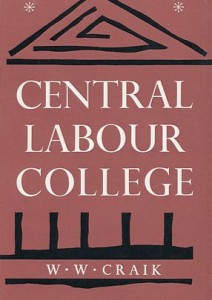Written by William Craik a railway guard who got kicked out of Ruskin College, Oxford and was then the principal of the CLC in the early 1920s
The Central Labour College schooled a whole generation of the brightest workers mainly from the mines and railways of Britain between 1909 and 1929. It was formed by the dissident students who had been thrown out of Ruskin college following a strike (see Colin Waugh ‘Plebs’ ISSN 0459-2026). The CLC was housed initially in Oxford until the University (which effectively owned the town) kicked them out to London.
The college’s main funding came from scholarships from the South Wales Miners Federation (this was a time before a national miners union) and the Amalgamated Society of Railway Servants (who became the NUR in 1921) other unions later sent members on individual scholarships. These two unions have often been characterised as Syndicalist. What I would argue is that the question of whether political struggle or industrial struggle was the road to the emancipation of the working class was a relevant dichotomy within all unions at that time – and both the SWMF and the ASRS certainly gravitated towards Industrial struggle. Students at the CLC would often argue over this question (Nye Bevan was apparently the last to go to bed having argued against political action into the small hours most nights during his two years there). Two events (which I won’t go into in any detail about here) changed the relevance of that dichotomy. The Bolshevik seizure of political power in Russia in 1917 and the failure of the general strike in 1926.
What the railwaymen and the miners shared at that time was the view that not only was the labour movements’ mission the emancipation of the working class. But that education was the key to that emancipation. But not any kind of education, they wanted nothing to do with bourgeois education – and resisted all attempts to be drawn into University life while based in Oxford. Similarly they resisted the push for a practically based education to give workers the skills for branch office and union work – the model which eventually triumphed after 1929.
The CLC was accused by some of its detractors of wanting to teach workers what to think but they countered that they wanted to teach workers how to think – dialectically:
They argued that as Darwin had introduced men and women as the historical products of evolution, Marx had introduced men and women as the historical products of social evolution- the self-made products of their own social activities (labour). ‘In the beginning was work and that work was the very life of men and women’. All relationships between men and women are entered into in the production and reproduction of life based on how they confront nature with their productive powers. These capitalist social relations are material social relations.
Marx fused materialism with the dialectic method of Hegel who interpreted all movement and historical development as a coming into being and passing into another form through a conflict of opposites or contradictions (thesis-antithesis-synthesis). Capitalism was not thought of, planned or willed by anyone it came out of a dialectic process by which new revolutionary forms of production (technology) confronted the old conservative feudal order until they had grown to such an extent that new social and economic relations became inevitable.
Marx argued that while Men and women may have learned to harness the forces of nature, they needed to learn to master the social forces they had unwittingly unleashed which had effectively mastered them. Teaching workers to see themselves within the context of this inter-connected universe and to master these social forces was the aim of the Central Labour College through an inspiring Curriculum that combined amongst other things; the History of Socialism in England (including John Lilburne and Gerard Winstanley), the Science of Understanding (Historical materialism), Study of the Trade Unions and Law, the Industrial revolution, Imperialism, Advanced Economics and Economic Geography.
Having effectively led Labour movement education in this country for 20 years and provided the graduates to organise and teach in regionally organised classes all over the country the college was closed in 1929. Following the general strike in 1926 the miners and railwaymen could not sustain their commitment and the Trade Union movement felt that funding should be concentrated on the regional classes which could in theory be more value for money by reaching more people. In Craik’s opinion the result was that Trade Union education was effectively ‘de-capitated’. Without the graduates to teach the curriculum the CLC had developed, what eventually came to dominate was a skills based education to train for branch office and union work.
There was a small minority in the 1929 Congress who raised the spectre of the trade union movement’s favourite bogeyman the Industrial Workers of the World and its’ supposed influence within the CLC (an ungrounded charge that was first levelled in 1909 when some Ruskin students attended an IWW meeting in Oxford). However it’s interesting to note that political criticism of the CLC’s Marxian curriculum was minimal and its’ detractors (who may or may not have been politically motivated) instead choose to argue solely on the grounds of thrift.
Also of note is that of all the CLC graduates only one, Frank Hodges passed over to the other side in the class war, the rest living out their working lives in the service of their class.
An Independent Working Class Education network exists today, inspired by examples such as the Ruskin striker’s ‘Pleb’s League’ and the Central Labour College. They meet regularly all over the country, and can be contacted via: iwceducation@yahoo.co.uk
